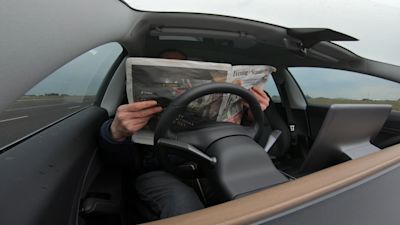Self-driving cars given green light for motorway use later this year - but how will they work?

Consumer Editor Chris Choi went for a hands-off spin
Self-driving cars enabling drivers to take their eyes off the road and their hands off the wheel could be permitted on UK motorways later this year.
The Department for Transport (DfT) announced it will allow hands-free driving in vehicles with lane-keeping technology on motorways with slow traffic, at speeds of up to 37mph.
It has set out how a vehicle with an automated lane keeping system (ALKS) could legally be used by a driver not paying attention, as long as there is no evidence to “challenge the ability” of it to be used autonomously.
So, how does the technology work and what are the risks?
How does ALKS work?
The system varies between manufacturers, but generally involves the use of cameras and sensors to keep a vehicle moving in its lane without hitting other road users.
ALKS enables a motorist to hand over control to their vehicle, although they must be available to resume the driving task.
It is designed to constantly monitor speed and keep a safe distance from other road users, normally through the use of cameras and sensors.
The DfT describes ALKS as “traffic jam chauffeur technology”.
What does that mean for motorists?
Drivers will be able to take their hands off the wheel and stop paying attention to the road.
It will be permitted later this year on motorways with traffic jams.
Cars will have a maximum speed of 37mph in self-driving mode.
How would self-driving cars work?
Does someone need to be in the driver’s seat for it to operate?
Yes. The system will only work if someone is behind the wheel with their seatbelt fastened.
The Department for Transport says that when ALKS detects an “imminent collision risk”, it carries out an “emergency manoeuvre” which can involving braking or evasive action.
The Government claims it can “improve road safety by reducing human error”.
The system also requires a driver to be able to take back control within 10 seconds if a problem is detected.
What happens if the driver fails to respond?
The car will slow down, its hazard lights will begin flashing and its infotainment system will turn off.
Have there been any accidents?
Concerns about autonomous vehicles were raised when two men were killed on April 17 when a Tesla Model S crashed into a tree in Texas.
Police believe no-one was in the driver’s seat when the collision occurred.
Tesla’s Autopilot system enables a car to steer, accelerate and brake automatically within its lane, but currently requires active driver supervision.
Tesla boss Elon Musk wrote on Twitter that “data logs recovered so far show Autopilot was not enabled”.
What has been the response to the Government’s announcement?
The automotive industry has described the policy as a welcome boost, but some motoring groups are concerned about whether enough testing has been done to allow hands-free driving.
A consultation has been launched on updates to the Highway Code to ensure autonomous systems are used safely and responsibly.
Jim Holder, editorial director of magazine and website What Car?, said the new policy is a “sensible first step” towards autonomous driving.
“These are very, very controlled circumstances, low speed, relatively straight roads, clear road markings,” he told the PA news agency.
“In theory this should be a very effective way of using the technology to good effect.”
He said the UK is in a “global competition” to develop the technology.
The announcement “gets us back in the race” as the UK is “a bit behind” the US and China, Mr Holder added.
While the DfT is confident safety measures can deliver, Steve Gooding, director of the RAC Foundation, said humans are “invariably the weak link” when it comes to driving safely, but he warned there are “challenges” when journeys involve a transfer of control between technology and the person behind the wheel.
“There is a risk of situations in which drivers over-rely on the automated system, expecting it to deal with events for which it is neither intended nor capable.
“And what happens when drivers are expected to take back control in an emergency? Research for us shows that it can take drivers several seconds to regain command of their vehicle.”
And AA president Edmund King claimed “we shouldn’t be in race to take drivers’ hands off the wheel”.
He went on: “There are still gaps in how this technology detects and stops if the vehicle is involved in a collision.
“There are still question marks over how drivers will be fully informed how these systems work.
“More needs to be done to rigorously test these systems before they are used on UK roads.”